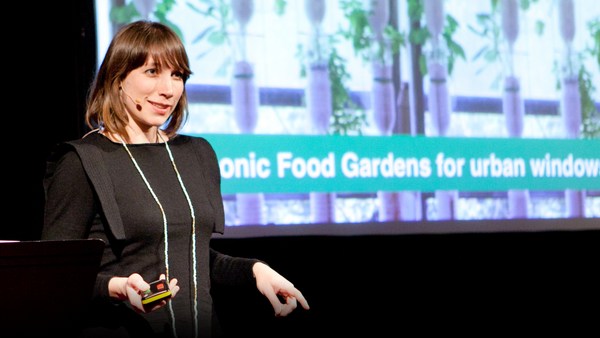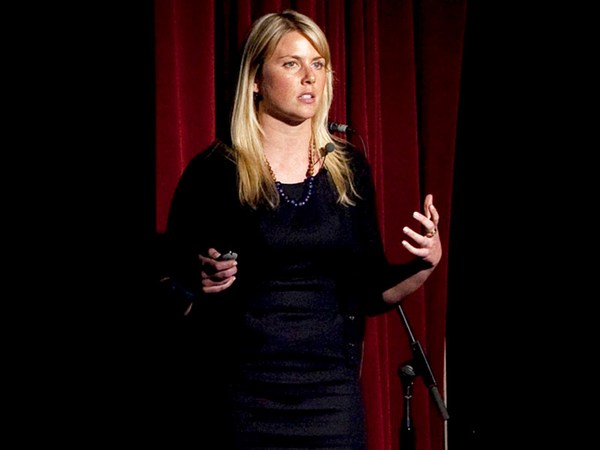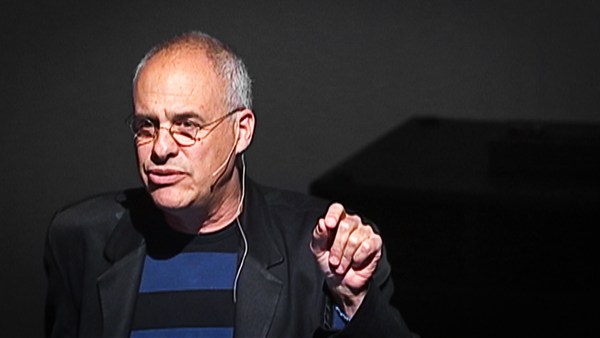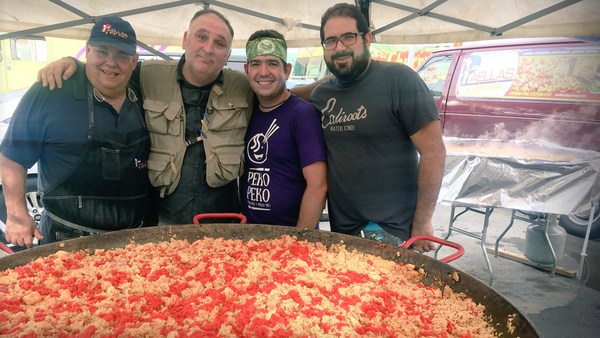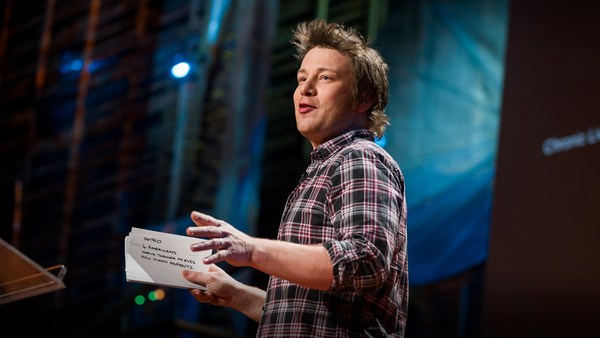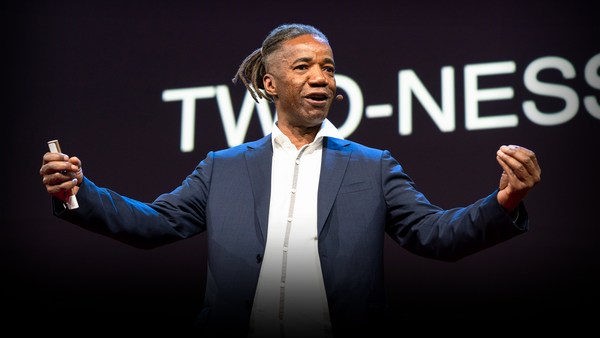So, my name is Roger Doiron, and I have a subversive plot.
(Laughter)
(Applause)
It is so subversive, in fact, that it has the potential to radically alter the balance of power, not only in our own country, but in the entire world. Now I realize, I'm sounding --
(Laughter)
a little bit like Dr. Evil now. I understand that. But trust me -- we have very, very little in common. His plots are all about destruction and secrecy, whereas my plots are about creation and openness. In fact, my plot can only work if I share it with as many people as possible. So I'm going to share it with you now, but you have to promise me you're going to share it in turn.
So here it is. Huh. That's not so good, is it? There's nothing particularly radical or revolutionary about a patch of grass. What starts to get interesting is when we turn it into this.
Now, I would like to suggest to you all that gardening is a subversive activity.
(Laughter)
Think about this: food is a form of energy. It's what our body runs on, but it's also a form of power. And when we encourage people to grow some of their own food, we're encouraging them to take power into their hands, power over their diet, power over their health and some power over their pocketbooks. So I think that's quite subversive, because we're also necessarily talking about taking that power away from someone else, from other actors in society that currently have power over food and health. You can think about who those actors might be.
I also look at gardening as a sort of healthy gateway drug, you might say, to other forms of food freedom. It's not long after you plant a garden that you start to say, "Hey, I need to start to learn how to cook."
(Laughter)
"You know, I might want to look into food preservation or I might want to look up where my local farmer's market is located in my town."
Now the other thing, of course, with planting a garden, especially a garden in front of a white house and on a sunny south lawn, is you never know who you might influence.
(Laughter)
Now, I'm not exactly sure what my white house garden's influence was on the First Lady's, but I can tell you this: she's had an enormous influence on me since planting hers. Now it hasn't been --
(Laughter)
it hasn't been in the area of fashion. I understand that she's just in a completely different league there, and I'm not even trying to compete. But she's really inspired me to think much more boldly about the role that I want to have in the garden movement.
And so this is sort of what I'm aspiring to here.
(Laughter)
Now, pretty modest, right? I like this picture. I think it sort of captures me well, not that I have any divine connections whatsoever, but I like my facial expression there, because, if I've got a worried look on my face, it's not simply because I've got 20 pounds of squash over my head, but it's because I've got some pretty heavy topics on my mind. And I want to share some of those with you right now, starting off in the form of a very short video I've produced for you, which is my best effort to sum up the history of gastronomy in about 15 seconds.
("Also sprach Zarathustra" plays)
(Laughter)
So, here we are.
(Applause)
Now, that's a funny little clip, but it'd be even funnier if it weren't so tragic and if it weren't so true.
The reality is that we are in the midst of an obesity epidemic, and it's not simply limited to our country. It's spreading around the world right now. And in a sort of parallel universe, we're also seeing that hunger is on the rise. Over 900 million people right now are affected by it. That's three times the population of the United States. But at the same time, world food prices are rising and world population is rising and is set to reach 10 billion people by the end of the century.
Now, another thing about the population is we know that it's increasing, but a lot of us don't realize that it's also changing. There's a fundamental shift taking place. As of 2007, we went from being a primarily rural planet to being a primarily urban one, and that has implications for how we're going to feed these people, how we're going to get the food to the people in the cities. Now, I imagine that there are some Stephen King fans in the audience here, and I'm one of them. But I can tell you, I haven't read anything scarier than this here, and that's this statistic: in order to keep up with the growing population, we're going to need to grow more food over the course of the next 50 years than we have grown over the course of the past 10,000 years combined.
What makes this even more challenging is that we're going to need to grow all this food with less, and when I say less, I mean a number of things. Less oil, for example. Most reputable geologists believe that we've already reached peak oil production in the world. Now, you might not think in terms of oil and food as being linked, but there's a very strong link, in fact. It takes 10 calories of fossil fuel energy in our highly industrialized food system in order to produce one calorie of food energy. We'll also need to grow more food with less water. These three images come from three very different parts of the planet, but they all tell the same story of catastrophic drought.
We'll also need to grow more food with less farmland. Here, the pressures differ from one place to the next. In the Global South, we're seeing desertification, whereas in the north, we're seeing suburban sprawl.
We'll also have to grow more food with less climate stability and less genetic diversity. Now, this is really important. We need our genetic varieties because they're a sort of insurance policy against climate change. We heard earlier today "not putting all of our eggs in one basket." Well, we shouldn't be doing the same with our tomatoes, either.
We're also going to need to grow more food with less time. Now here, I'm not simply talking about the ticking time bomb that is the global population. I'm talking about the amount of time we all have in order to put a decent meal on the table. And that "31" figure there is not something arbitrary. That's the average amount of time the American family spends preparing, eating and cleaning up after meals per day. 31 minutes. So somewhere in there, we're going to need to also fit in growing food. Alright? And I think we do need to do that, but that's also going to mean that somewhere along the way, something's going to have to give. So it sort of leaves us feeling like this.
(Laughter)
You know? It's time to leave town or even perhaps leave planets. But where do we go? Where do we go when we only have one planet? And where do we go where the going gets tough?
Well, if we were to listen to a lot of our political leaders over the years, we would simply go shopping. Right? Because we have this unwavering belief, especially in American political culture, that we can shop our way out of just about any problem. But the reality is something different. We're not going to solve our food problems and our health problems simply by switching from regular Coke to some future green iteration thereof. And although the large food companies would like us to believe that we can give our children all of the vitamins, minerals and immunity-building substances that they need without even leaving the chocolatey cereal aisle --
(Laughter)
the truth is something quite different.
Now, what's become even more troublesome of late is that even the foods that ought to be healthy aren't always so, and we're starting to lose confidence in our food system, I think. The bigger it becomes and the more complex it becomes. And we've seen this time and time again. This is an image from the latest E. coli outbreak. In this case, it was in Europe, and we think it was started with bean sprouts, of all things.
So we have this sort of shopper's dilemma right now. We have all of these different foods -- 30,000 foods in the average big-box grocery store -- but we have less confidence in those foods, and we have less confidence in the actors that are putting those foods on the shelves. I think we need to redefine what good food is. This is an interesting image from Berlin, Germany, where somebody started planting shopping carts and leaving them around. Those are potatoes, by the way.
But in addition to redefining what good food is, I think we need to redefine our living spaces. Instead of seeing this as a yard, we need to think of it more as like a full-service greengrocer. That's, in fact, my yard, and that's how I look at it. That's what we transformed our yard into, and I think a really key message is this one: gardens grow good food. And when I say good food, I mean a number of different things. I mean food that is safe, food that is healthy, food that is absolutely gorgeous and delicious.
Another important message is this one: gardens grow healthy kids and families. Those happen to be my two youngest sons, and they look healthy and they are healthy, and I think it has to do with the fact that they grew up in gardens and they know where good food comes from. And in fact, they know how to grow some of it themselves. But in the current economy, I think it's key to get this message out, that gardens also grow important economic savings for families. And you can pretty much take my word on this one, because in addition to crunching the vegetables a couple of years ago, my wife and I also crunched the numbers, and we found out that at the end, we had saved well over 2,000 dollars by growing our own food.
So you could be asking this question now: If gardens grow all of these great things, how do we grow more gardens? That's, in fact, the question that my organization, Kitchen Gardens International, is both asking and answering. And our answer is essentially this one: we're going to need to leverage the resources and power that we have, the gardens and gardeners that we have, in order to grow and inspire even more. And as I said before, you never know who you might inspire.
(Laughter)
Now if this campaign was successful, I think it wasn't simply because we had a visionary First Lady taking up residence at the White House -- that certainly was a major part of it -- and it wasn't simply because we had some celebrity chefs and authors saying this would be a good idea to do. I think it was ultimately made possible by the fact that there were a lot of people who wanted it to happen. There was a movement that made it happen. And my organization tried to sort of channel some of that energy of the movement and direct it towards the White House. And we had a lot of luck in terms of getting our message out there to the media. We had a petition on Facebook, 110,000 signatures. We had viral images and videos, and we did crazy things like symbolically putting the White House lawn up for sale on eBay.
But we need to do even more, and what we're trying to do in my organization is to connect people online, but also to connect people in person. This is an image from a little holiday we invented called "World Kitchen Garden Day." It's at the end of August each year, and it's just about bringing people together in gardens to learn from one another, to experience a garden as a community experience. We also need to grow the next generation of gardeners, and we're doing that in the United States and abroad.
But there's still so much more that needs to be done, and I think this slide sort of captures where we need to go. We need a road map, and I picked this slide for a reason. We've got a bike garden on the left and a map of the Netherlands on the right. I was in the Netherlands early this year and was absolutely amazed by the amount of bikes on the road; 26 percent of all trips taken in the Netherlands are by bicycle, and it's gotten me thinking: How do we get that happening in terms of food and gardens? How would we get 26 percent of all produce coming from backyard gardens? That might sound like a lot, because we're probably at about two percent at the most right now. But if you take into consideration that at the peak of the victory garden movement last century, 40 percent of all produce was coming from gardens. We can get there again. And I think this is a really good start. The White House garden is certainly very inspirational. That's actually sort of a snapshot of what the garden looked like when it was planted earlier this spring -- lots of diversity, lots of healthy crops. However, this is not a good representation of our federal agriculture policy.
(Laughter)
If we were to take the model here, the diagram of that particular garden, and sort of transpose it onto our federal agriculture policy, we'd get this: billions of billions of dollars going to support just a handful of commodity crops with just that tiny little bit at the top for fruits and vegetables. This is scandalous. This is scandalous. We need to do something about this. I think one place we could start is we could look at the tax code. We're already using the tax code to encourage green transport and green shelter. Why not green food? We're in the midst now of talking about another stimulus package. Why not a garden stimulus package? Why not?
(Applause)
In terms of other things that we need to be doing, we need to move down to the local level and we need to make sure that gardens are legal. This is an illegal garden. At least it was. It's from Michigan earlier this year. It was planted by a woman, a mother of four, and she nearly faced a 93-day jail sentence because she planted it in her front yard. We still have laws from the 20th century. We need to bring our codes up to the realities that we are facing now. We need to figure out also new ways of getting people into gardens, people who don't have yards. I think we also need to set garden entrepreneurism free, and I'm happy to say, as a Mainer, that we are leading the way in this area. Earlier this year, a number of Maine towns passed local food sovereignty laws that allow town residents to not only grow food where they want to grow it but to also sell it the way they want to sell it and to the people they want to sell it to. I think that's an incentive. There are a lot of gardeners out there that would be interested in scaling up their production if they could, if they had a financial incentive.
I also think that we need to examine the composition of the movement right now.
(Laughter)
If the movement were a 1960s beach flick, it would be "Where The Boys Aren't."
(Laughter)
So I'm going to take you to task, guys. It's not right and it's not fair that the burden of this responsibility -- feeding our country and the world -- should be with the women. OK?
(Applause)
And I'm going to challenge the women to come up with really clever, creative ways of getting guys into the gardens, too.
(Laughter)
Perhaps wearing a bathing suit?
(Laughter)
But beyond that, I think we need to reexamine the infrastructure that we have in place for gardens. I think we need to create new infrastructure. And this is one of the things my organization is working on right now, sort of a local communications infrastructure, very place-based, that allows people in the same area to connect with one another and to help each other out. I think we're lacking this at the moment --
(Laughter)
but we can do it. The technology is certainly there.
In addition to that, I think we need another type of infrastructure. It would be good if we could all get together. I think if we've learned anything through the TED experience, it's that there is power when we bring people together, and I think we need to bring people together at the local level as well. And I think we can take some inspiration from a previous movement, which was the grange movement, a rural movement which brought farmers together in a single building to meet and to recreate and learn how to become better farmers. I think we need a network of suburban granges now.
I think one of the last things that we need is to not lose the fun of food. Food is at its best when it's delicious but shared as part of a community, and I think that gardens can get some of that community vibe back as well. So I'm going to leave with one last video, and I'm going to revisit the short video that I showed you before, but I'm going to suggest an alternative ending. And I think this ending is well within our reach, but it's really going to require that we all pull together. So here's the new history of gastronomy.
("Also sprach Zarathustra" plays)
(Applause)
(Applause and cheers)
Thank you very much. Thank you all. Thank you.
